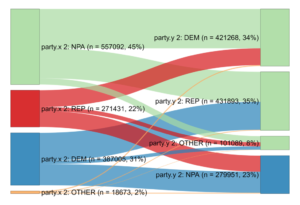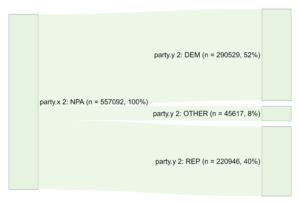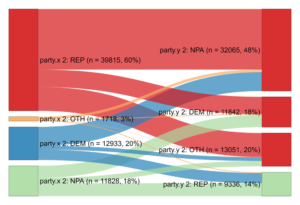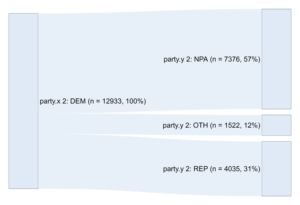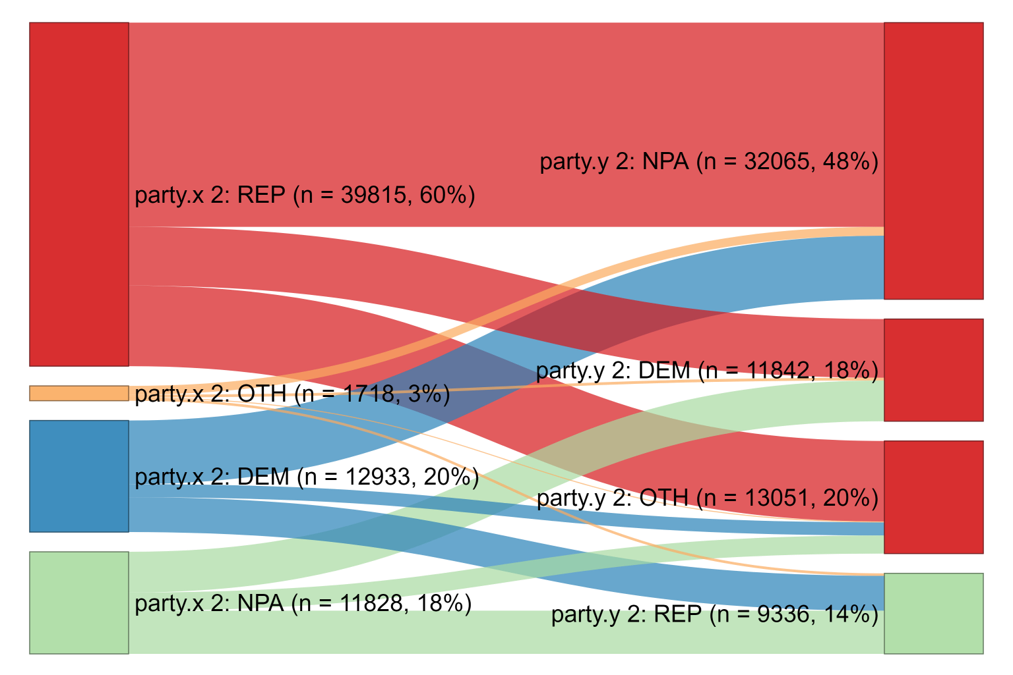
Are Republicans Fleeing the Party in Florida?
If you believe the press, Republicans are fleeing the party by the thousands – especially after the Jan 6 incident at the capitol.
Well, we don’t believe the press at face value, and we prefer to compile our own data and make our own conclusions.
In the past, we have explored the tremendous amount of churn in Florida’s voters file.
However, in this case the research question is “In Florida, are Republicans leaving the party? Follow up: How does that rate compare to Democrats leaving their party? Is there an uptick in Replicans leaving the party?”
Methodology
I found some old voter-files in a desk drawer.
file 1 – Florida Voter-file December 2017
file 2 – Florida Voter-file December 2020
file 3 – Florida Voter-file – February 2021
Exploration 1: December 2017 –> February 2021.
Exploration 2: December 2020 –> February 2021.
I loaded each voter file in its entirety. Then I joined each by the state’s voter ID number. I dropped any observations that were not on both rolls. Then I simply looked at the party registration in the first file, looked at the party registration in the second file and if they differ deemed them a “switch”.
Florida Voters December 2017 vs Florida Voters February 2021
In this graph, on the right hand side is Dec 2017 and on the right hand side is the switch. This graph allows us to see how the switches flowed. (click the graph for a larger view.)
But this shows us that in that time, 271,431 (22% of total switches) Republicans switched their registration compared to 387,005 (31% of total) Democrats, and 557,092 (45% of total) NPAs.
So in this time period, MORE Democrats in Florida fled their party.
R Detail
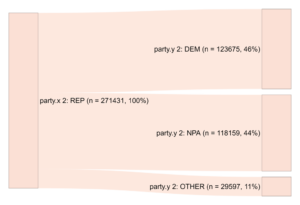
In this Rep detail, 46% of the switches moved from Rep to Dem, 44% of the switches moved to from Rep to NPA, and 11% moved to Other.
Dem Detail
In this Dem detail, 53% of the switches moved from Dem to Rep, 40% of the switches moved to from Dem to NPA, and 6% moved to Other.
NPA Detail
In this case, 52% of the switches moved from NPA to Dem, 40% of the switches moved to from NPA to Rep, and 8% moved to Other.
Florida Voters December 2020 vs Florida Voters February 2021
In this case we redo the counting, but comparing Dec 2020 to Feb 2021.
In this graph, on the right hand side is Dec 2020 and on the right hand side is the switch. This graph allows us to see how the switches flowed. (click the graph for a larger view.)
This shows us that in that time, 39,815 (60% of total switches) Republicans switched their registration compared to 12,933 (20% of total) Democrats, and 1,718 (3% of total) NPAs.
So, we observe a dramatic increase in the proportion of switches – Republicans are moving in greater numbers than they have in the past two years.
R Detail
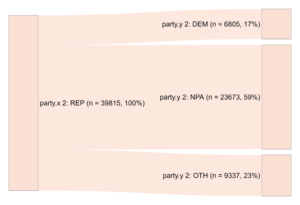 In this case, 59% of the switches moved from Rep to NPA, 23% of the switches moved to from Rep to Other, and 17% moved to Dem.
In this case, 59% of the switches moved from Rep to NPA, 23% of the switches moved to from Rep to Other, and 17% moved to Dem.
Dem Detail
In this case, 57% of the switches moved from Dem to NPA, 31% of the switches moved to from Dem to NPA, and 12% moved to Other.
NPA Detail
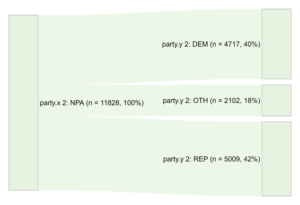 In this case, 42% of the switches moved from NPA to Rep, 40% of the switches moved to from NPA to Dem, and 18% moved to Other.
In this case, 42% of the switches moved from NPA to Rep, 40% of the switches moved to from NPA to Dem, and 18% moved to Other.
Plot twist
In an interesting plot twist and going against the conventional wisdom that the GOP is bleeding ‘suburban women’, 51% of Republican party switchers are male. Of the Democrat switchers 56% of them are female.
CONCLUSION
In the larger context, in the past two years, the Democrat party lost 387,005 voters to other parties while the Republican party lost 271,431 voters to other parties. This is compared to 557,092 NPAs that registered with a different party – 52% of them registering as Dems and 40% of them registering as Rep.
REMINDER: this analysis is not looking at new registrations or removals (death).
However, the data doesn’t lie and there is a red flashing light:
In the past 2 years, 22% of the voters switching parties were Republicans.
In the past 2 months, 60% of the voters switching parties were Republicans.
The rate of Republicans switching parties has definitely increased in comparison to a base line and it is something to watch very closely moving forward.

